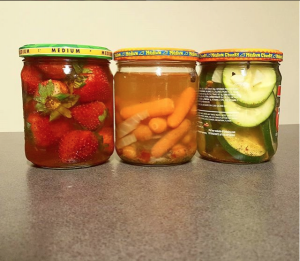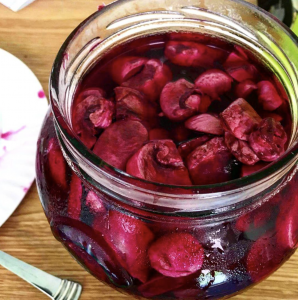Angsty_pickles Instagramer Tres Fimmano’s ’18 introduction to pickling came in the form of an unexpected blueprint for pickled eggs on the back side of a recipe for pancakes. “Out of curiousity, I tried them,” said Fimmano about the eggs. Lo and behold, the chance recipe introduced Fimmano to the world of pickling, a culinary specialty he still works on today, two years later.

Pickling, a form of fermentation, Fimmano explained, is a process that allows for the preservation of food, specifically hard-boiled eggs and vegetables. “If you have produce and vegetables that you want to hold onto for a long time, pickling allows you to save them for longer,” said Fimmano, noting the positive environmental impact pickling can have.
By way of a cooking process that takes about 20 minutes, Fimmano is able to experiment with a variety of spices and vinegars to create batches of pickled vegetables. “This is going to sound really corny, but really every pickle is different,” said Fimmano as to why he is so passionate about the process.
As a beginner, he stuck to a few specific recipes that he knew were good. Yet, as he became more familiar with the spices and their flavors, Fimmano began experimenting on his own. “I just find some spices like ‘oh, I haven’t tried this together,’ or ‘I liked this last time, maybe I’ll do more of that spice,” he explained. “That’s what’s really fun about it for me … I’m constantly able to try new things but also follow a pretty familiar structure that I know is reliable.”
When preparing pickles for friends, Fimmano tires to stick to the basics, such as Garlic Dill Pickles and Bread and Butter Pickles, or pickles that tend to sound most appetizing to people unfamiliar with the pickling processes. However, left to prepare pickles for himself, Fimmano has found his favorite recipe to be one that “does not sound particularly appetizing … to most people”—pickled eggs in red-wine vinegar and beet juice.

Just as the name describes, Fimmano’s favorite recipe is that of hard-boiled eggs soaked with beets in red-wine vinegar. “They have a really dark-red, purplish stain to them that even kind of fades into the inside of the white of the egg,” said Fimmano. When he cuts the egg in half, he is able to see where the purple stain seeped into the white of the egg. “It looks really cool. It tastes delicious,” he said, emphasizing the vinegar flavor he has come to love since he started pickling.
Though failure is not a word Fimmano used to describe any of his pickles, he did note that despite his best efforts, he was not able to appreciate pickled carrots. “I tried to get into pickling carrots for a long time, and not only did I find that very boring because they didn’t really retain a lot of flavor of the spices, but also whenever they did pull in spices, it wasn’t very useful,” said Fimmano. He recalled one batch of carrots that he flavored with mustard seed and resulted in something “that just tasted like a really bad carrot.”
As much joy as pickling brings Fimmano in the kitchen, he loves being able to introduce other pickle-lovers to the process. “Something that I really enjoy is when I mention to someone that I like pickling, and they’re all of a sudden like ‘oh my god, I love pickles,’ because all of my friends think it’s one of the weirdest things about me,” said Fimmano. “But you’ll realize how many people are just so into pickles, and they don’t realize how easy it is to make their own, and I really discovered that there really is a pretty strong cult following of pickles.”
For any new picklers, Fimmano recommends first checking out a few recipes and then to “just stop using them, because you’re going to have the most fun just finding a spice that you think will be interesting and throwing it in there, and you’re only going to get there by trying it.” To get any interested readers started with their first batch of homemade pickles, Fimmano shared one of his favorite homemade recipes with The Brandeis Hoot’s readers. He suggests starting with cucumbers, as they have the least natural flavor, and then moving into other vegetables from there.
Tres’ Beginner Pickle Recipe
Ingredients
Pickling Cucumbers, Chips or Spears (as many as will fit in your jar)
White Vinegar (¾ of your jar)
Salt (1 tablespoon)
Pickling Spices (1 tablespoon)
Finely Chopped Garlic (4 cloves)
Dill (2 teaspoons)
Sugar (1 tablespoon)
Chopped Onion (½ onion)
Note: pickling spices are sold as a mix that can be purchased at Hannaford’s or Market Basket.
Recipe
First, bring the vinegar to a boil. Depending on how strong you want the pickles to be, you can use anywhere from 50 to 100 percent vinegar. “I personally really like doing an entire jar of just vinegar, but some people find that very overwhelming, so if I’m trying to make a jar that’s for someone else, or if I’m going to share, it will be closer to about 50 percent vinegar and 50 percent water,” explained Fimmano. The vinegar should fill about three quarters of the jar you are making the pickles in.
While the vinegar is boiling, measure out and prepare the salt, garlic, dill, sugar, pickling spice, and onion. While the onion can be cut in whatever way is easiest for you, Fimmano prefers to chop larger pieces, as he “like[s] the aesthetic of the long rings of onion in” the jar.
When the vinegar boils, add the spices, garlic, and onion, cover the pan, and bring the mixture to a simmer for 10 minutes. During those 10 minutes, cut up whatever vegetables you are using. For this recipe, Fimmano suggests pickling cucumbers, which can be prepared as sliced chips or spears.
After the vinegar has simmered for 10 minutes with the spices, quickly pour it into the jar of cucumbers, seal the container, and put it in the refrigerator to sit overnight. They will be ready to eat as early as the next morning!


